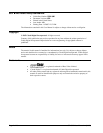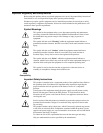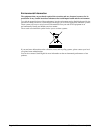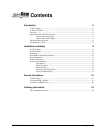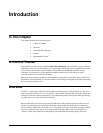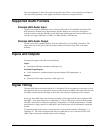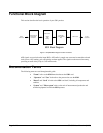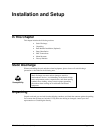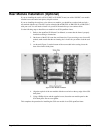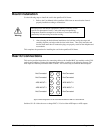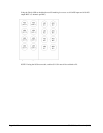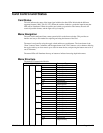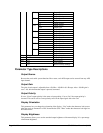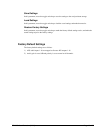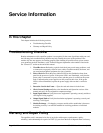
CDI-9323 User Manual •
••
• (V 0.5) Page 7 of 20
All card configuration is done with a simple front panel menu. There is a four character text display to
view and control parameters, and a toggle switch and two buttons to navigate the menu.
Supported Audio Formats
Discrete AES Audio Input
The 9301 can accept 16 channels (8 pairs) of discrete AES audio on 75 ohm BNC connections. The
AES must have a nominal rate of approximately 48 kHz. Sample rate conversion is employed to
account for minor clock rate differences in the AES stream and the input video stream. However, the
card does not support AES input at 32 kHz, 44.1 kHz, 96 kHz or 192 kHz rates.
Discrete AES Audio Output
The 9301 can emit 16 channels (8 pairs) of discrete AES audio on 75 ohm BNC connections. The
output clock rate of each pair is precisely locked, and derived from the input AES, or the frame
reference.
Inputs and Outputs
The input and outputs of the 9301 are the following:
Inputs:
4 dedicated AES input connections (AES input 5-6)
Switchable Input/Outputs:
4 AES connections, switchable between input and output (AES input/output 1-4)
Outputs:
8 dedicated AES output connections. (AES output 1-8)
Signal Timing
The input AES audio rate must be 48 kHz (± 1%) nominally. There are sample rate converters on each
input that allow the use of asynchronous sources, but the rate must be 48kHz. The output clock rate will
be 48 kHz as defined by the AES input, or the frame video reference, depending on user selection.
In the case where AES input is the reference, the timing will be taken from the lowest numbered AES
input BNC. If you have connections to AES inputs 3, 5, and 8, AES input 3 will be the timing master
and AES 5 and 8 will be resampled accordingly. Consequently, to slave the output timing to a DARS
audio reference, simply connect it to AES input 1 and all other inputs will be resampled to match that
channel.
To match the output audio clock to a video reference, select the frame reference (“Reference 1” or
“Reference 2”). The card will automatically detect any black burst or tri level format (NTSC, PAL,
1080i, 720p) and generate a 48 kHz output clock accordingly.




